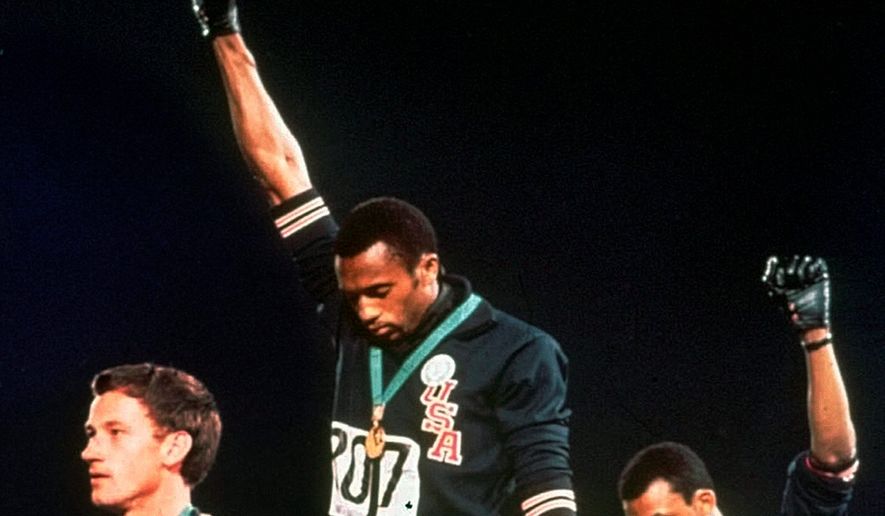Protests by Tommie Smith, John Carlos still resonate 50 years later

By DERON SNYDER (as published in The Washington Times)
Fifty years ago on Oct.16, Tommie Smith and John Carlos walked to the podium to accept their respective gold and silver medals after the 200-meter sprint at the Olympic Games in Mexico City.
Wearing beads and a scarf, as their first sign of protest, they took off their shoes and stepped onto the stand. And when the United States national anthem was played, they lowered their heads and raised a black-gloved fist in a salute beamed around the globe.
Just six years old at that point in 1968, I didn’t realize the impact of those actions – or the consequences Smith and Carlos faced – until many years later. The iconic photograph had been etched in my brain long before then, but I had no idea of everything behind their act of defiance.
It’s a lesson worth learning, especially now, as some of the same issues still resonate lead to other forms of protest.
A half-century before Colin Kaepernick took a knee and put his NFL career on the line, Smith and Jones raised their fists and put the world on notice.
Back then, Dr. Harry Edwards was a burgeoning social-justice crusader and former track athlete, organizing black students at San Jose State and elsewhere. Through his book “The Revolt of the Black Athlete” (1968), we see he was the driving force as colleges slowly addressed the rampant unfairness and inequality faced by athletes and non-athletes.
For those who prefer a shorter version, Beckham Publications released a BookSquint Summary last summer (www.bitly.com/revoltBA) – edited by yours truly – in recognition of the Mexico City Game’s 50th anniversary. It provides a fascinating, behind-the-scenes look at the wave of activity on campuses nationwide that spawned the Olympic Project for Human Rights.
Edwards’ experience as an athlete led him to fight for change. He helped San Jose State’s black students protest racially discriminatory housing in 1967 and got the black football players involved, too. The New York Times reported that the Spartans’ season opener became the first college football game cancelled “because of racial unrest.”
Complaining about “unrest” is easy when the issues don’t affect you. Or when you decide that some folks raising objections are too privileged to complain. Or when you deny the existence of any issues at all.
But it’s not easy to ignore when the Olympic Games are impacted.
Edwards, Smith, Jones, and others threatened the sanctity of national pride and international athletic competition. For their troubles they received hate mail, death threats and scathing media criticism. But by shining a light on black athletes’ plight in America, they showed that sports – contrary to popular opinion – wasn’t immune to the ills of racism everywhere else in our society.
The initial plan was for an outright boycott. That would’ve had a devastating effect on the U.S. Olympic team’s prospects (remember, these were the “summer games”). With the help of famous supporters like Martin Luther King Jr. and Lew Alcindor, as well as little-known public figures like Smith and Jones, the movement successfully captured the world’s attention.
Clearly, there was no boycott of the 1968 Games in Mexico City. But it’s just as clear that the Olympic Project for Human Rights was an overwhelming success.
Not every athlete demonstrated as boldly as Smith and Jones. Not every demand by the OPHR was met right away. Not every problem facing black athletes disappeared overnight.
Nonetheless, Edwards put the nation on notice that a new era was underway. And we’ve seen evidence that it continues to this day, from college football players going on strike to NFL players taking a knee.
The latter group’s protests are focused primarily on police brutality. That’s not a new issue, but it wasn’t at the front of Edwards’ movement, which zeroed in on housing, employment, and cultural opportunities for blacks in college and the sports arena.
In January, at a 50th anniversary celebration of Vanderbilt basketball players Perry Wallace and Godfrey Dillard integrating the Southeastern Conference, someone mentioned the difference in today’s era with so many black faces.
“There’s a difference between progress and profit,” Edwards said during a panel discussion. “There’s been progress on the field, but it hasn’t profited us in other areas of sports.”
Some areas of concern have changed in the last half-century. But many of the root issues remain in place today. While the ranks of black coaches and administrators have swelled far past the meager totals Edwards listed in 1968, his point refers to the numerous sport-related jobs that remain harder-to-get for non-whites.
The sports industry remains a multi-billion-dollar behemoth with a plethora of income streams outside of being a pro athlete, coach or administrator. Yet, the farther you stray from the playing surface, the fewer black faces you see. Much of the overt racism Edwards documents has given way to subtler forms and fashions (thought blatant expressions are on the rise since November 2016).
But as he wrote in his conclusion, “the revolt of the black athlete can no more be thwarted or reversed than the rivers of the world can be made to flow away from the oceans.”
There might never be a flood.
But there will always be at least a trickle.
— Brooklyn-born and Howard-educated, Deron Snyder writes his award-winning column for The Washington Times on Tuesdays and Thursdays. Follow him on Twitter @DeronSnyder.
 Follow
Follow
